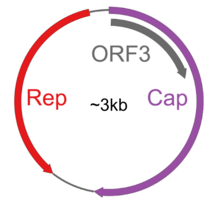Redondoviridae
Redondoviruses (members of the Redondoviridae) are a family of human DNA viruses. Their name derives from the inferred circular structure of the viral genome (“redondo” means round in Spanish). Redondoviruses have been identified in DNA sequence based surveys of samples from humans, primarily samples from the oral cavity and upper airway.[2][3][4].

| Redondoviridae | |
|---|---|
| Virus classification | |
| (unranked): | Virus |
| Realm: | Monodnaviria |
| Kingdom: | Shotokuvirae |
| Phylum: | Cressdnaviricota |
| Class: | Arfiviricetes |
| Order: | Recrevirales |
| Family: | Redondoviridae |
| Genus and species[1] | |
| |
Virology
Taxonomy
Redondoviruses are provisionally assigned to a new family by the International Committee on Taxonomy of Viruses (ICTV), the Redondoviridae.[4][1]
Classification
The family Redondoviridae is provisionally divided into two species, Brisavirus and Vientovirus.[4] The names derive from the words for breeze and wind in Spanish (“brisa” and “viento”), denoting the association with the human airway. Multiple strains have been proposed on the basis of viral genome structure.
The redondoviruses are members of the Circular Rep-Containing Single Stranded (CRESS) DNA Virus group[5].
- Phylum: Cressdnaviricota[6][7]
- Class: Arfiviricetes[6] (Ar from arginine; fi from finger; describes a feature of the Rep protein conserved among viruses in this class)
- Order: Recrevirales[6] (Re from redondoviruses; cre from CRESS)
Genome
The redondovirus genome is circular, and by analogy to other CRESS viruses likely single stranded. Genomes range in size from about 3.0 to 3.1 kilobases. The genome encodes three inferred proteins:
- A Rep protein that likely initiates rolling-circle DNA replication.
- A Cap protein that likely self-assembles to yield icosahedral particles.
- An ORF3 protein of unknown function. ORF3 is entirely encoded within the Cap coding region in a different reading frame.
Epidemiology
Distribution
Redondovirus genomes have been reported primarily from human samples surveyed using metagenomic DNA sequencing. They have been found primarily in oral and airway specimens[3][4].
Disease associations
It is unknown whether redondoviruses cause human disease. Some CRESS viruses are known pathogens, such as porcine circovirus type 2[8]
Redondoviruses have been reported associated with periodontitis. In one study, the levels fell with successful treatment.[4]. Abundance of redondovirus genomes has also been found to be high in some intensive care unit patients. At present the basis of these disease associations is unclear.[4]
References
- Abbas, AA; Taylor, LJ; Collman, RG; Bushman, Frederic D. (14 October 2019). "Create one new family (Redondoviridae) for circular, Rep-encoding DNA viruses". International Committee on Taxonomy of Viruses (ICTV). Retrieved 25 February 2020.
- Noell, Kristin; Kolls, Jay K. (May 2019). "Further Defining the Human Virome using NGS: Identification of Redondoviridae". Cell Host & Microbe. 25 (5): 634–635. doi:10.1016/j.chom.2019.04.010. PMC 6849504. PMID 31071291.
- Cui, Lunbiao; Wu, Binyao; Zhu, Xiaojuan; Guo, Xiling; Ge, Yiyue; Zhao, Kangchen; Qi, Xian; Shi, Zhiyang; Zhu, Fengcai; Sun, Lixin; Zhou, Minghao (November 2017). "Identification and genetic characterization of a novel circular single-stranded DNA virus in a human upper respiratory tract sample". Archives of Virology. 162 (11): 3305–3312. doi:10.1007/s00705-017-3481-3. ISSN 0304-8608. PMID 28707271.
- Abbas, Arwa A.; Taylor, Louis J.; Dothard, Marisol I.; Leiby, Jacob S.; Fitzgerald, Ayannah S.; Khatib, Layla A.; Collman, Ronald G.; Bushman, Frederic D. (August 2019). "Redondoviridae, a Family of Small, Circular DNA Viruses of the Human Oro-Respiratory Tract Associated with Periodontitis and Critical Illness". Cell Host & Microbe. 26 (2): 719–729.e4. doi:10.1016/j.chom.2019.07.015. PMC 6510254. PMID 31071295.
- Zhao, Lele; Rosario, Karyna; Breitbart, Mya; Duffy, Siobain (2019), "Eukaryotic Circular Rep-Encoding Single-Stranded DNA (CRESS DNA) Viruses: Ubiquitous Viruses With Small Genomes and a Diverse Host Range", Advances in Virus Research, Elsevier, 103: 71–133, doi:10.1016/bs.aivir.2018.10.001, ISBN 978-0-12-817722-8, PMID 30635078
- Walker, Peter J. "2019.012D.A.v1.Cressdnaviricota" (XLSX). International Committee on Taxonomy of Viruses (ICTV). Retrieved 25 February 2020.
Cressdnaviricota Arfiviricetes Recrevirales Redondoviridae
- Krupovic M, Varsani A, Kuhn J, Kazlauskas D, Breitbart M, Delwart E, Rosario K, Yutin N, Wolf YI, Harrach B, Zerbini FM, Dolja VV, Koonin EV (2019). "Create 1 new phylum (Cressdnaviricota) including 2 classes and 6 orders for classification of CRESS-DNA viruses". ICTV Taxonomy Proposal 2019.012D.A.v1.Cressdnaviricota.CS1 maint: multiple names: authors list (link)
- Meng, Xiang-Jin (January 2013). "Porcine Circovirus Type 2 (PCV2): Pathogenesis and Interaction with the Immune System". Annual Review of Animal Biosciences. 1 (1): 43–64. doi:10.1146/annurev-animal-031412-103720. ISSN 2165-8102. PMID 25387012.